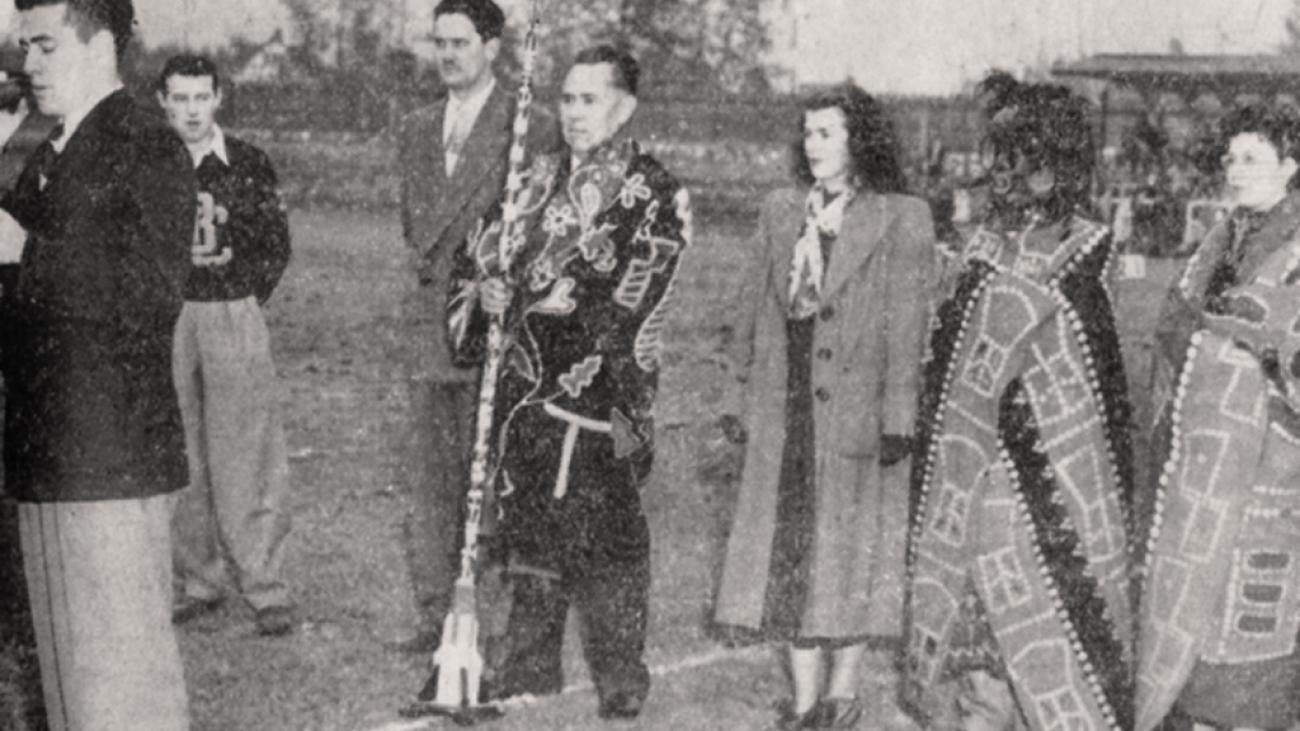How the Thunderbird Came to UBC
The Thunderbird is a supernatural creature from Aboriginal mythology that beats enemies with its wings and rends them with its talons. It’s also a potent symbol for UBC’s sports teams.
In November 1933, the sports staff of the Ubyssey published an article with the fanciful title “Zoological Cognomen Needed for Our Athletic Teams,” which began:
“Students of U.B.C., are you aware that our institution is lacking an important phase of college life? So important is this deficiency that one wonders how it has gone unnoticed. While other universities possess admirable mascots, nicknames, or what have you, for their athletic teams, we have none. Why should not U.B.C. take its place among the horde of Bears, Trojans, Huskies, Mules, Muskrats, Giraffes, and other wonderful aggregations that cavort each Saturday.”
The article called on students to suggest a name for UBC sports teams – something “that roars, screams, growls, or at least shrieks” – and jokingly offered “a complete set of season tickets (used)” for the best suggestion.
Perhaps because of the jocular tone of the article, few suggestions were submitted. Among these early entries were Lions, Pacific Pachyderms, and (an entry ahead of its time) Grizzlies.
Perturbed by the lack of response, the Ubyssey sports department produced another article, this time with a more serious tone, calling for names “in keeping with the history or geographical location of our University.”
The Thunderbird is a supernatural creature which produces thunder by flapping its wings and lightning by opening and closing its eyes. It can also beat its enemies with its wings and rend them with its talons.
At first, there were again only a few entries, among which were Cyclones, Seagulls, and Musqueams, the latter suggested because the campus was located on traditional Musqueam land. Then on November 24, 1933, Clarence Idyll, a member of the sports staff, suggested in a letter to the editor that the name Thunderbird be adopted, noting that it is “common in BC Indian mythology and seems appropriate.”
Perhaps the Thunderbird name was thought appropriate for sports teams because of its powerful connotations. In Aboriginal mythology, the Thunderbird is a supernatural creature that produces thunder by flapping its wings and lightning by opening and closing its eyes. It can also beat its enemies with its wings and rend them with its talons.
The Aboriginal connection also must have seemed appropriate. From very early times at UBC, Aboriginal names were used in various contexts, and in ways that today would be considered culturally inappropriate. For instance, one of the early UBC student cheers began with an invocation of the names of various tribes (“Kitsilano, Capilano...”). And the student annual formerly published by the Alma Mater Society was known as The Totem.
However, the name Thunderbird was not instantly accepted once it had been proposed. In fact, in late November and December 1933, there were suddenly a number of new entries in the contest to name the sports teams, including silly ones like Morons, Sea Slugs, and Peewits; ones that were already used by other universities, such as Huskies, Cougars, and Wildcats; and ones that the contest administrators said were not appropriate to UBC, such as Aztecs, Incas, Mohawks, and Apaches.
Still, there were enough serious entrants to have an election in which 25 names were listed on the ballot, among them Tartars, Cossacks, Philistines, and Prowlers. Other names on the final ballot included Golden Eagles, Corsairs, Musqueams, Spartans, and Seagulls – and unexpectedly Seagulls won. However, the sports staff at the Ubyssey decided Seagulls was not the best name and determined to have a new vote.
Such a vote was eventually held at a special pep rally on January 31, 1934, at which time Thunderbird won, garnering 320 of the 839 votes cast. Runner‑up was Golden Eagles with 178 votes, and Grizzlies came third with 101.
By February the Ubyssey was referring to the basketball team as the Thunderbirds, and by March was using the term for the varsity rugby team and the ski team.
And that is how the Thunderbird came to UBC – although not yet with permission. That didn’t come until 15 years later, when at a formal ceremony during half‑time at the 1948 Homecoming football game, Chief William Scow of the Kwiksutaineuk people granted permission for the use of the Thunderbird name and donated a totem pole named “Victory Through Honour” (carved by Ellen Neel) to the AMS.
And as to the poor seagull, cheated out of its rightful victory in 1933? Well, in 2014‑15 the AMS brought it back to life, declaring the seagull to be the mascot for the new student union building, coincidentally named the AMS Student Nest, and someone in seagull costume could even be seen wandering the halls.
Thunderbirds in China: In the 1970s, the UBC men’s hockey team went to China to share their playing skills. Les Rose made a documentary about it for The National Film Board of Canada.

































